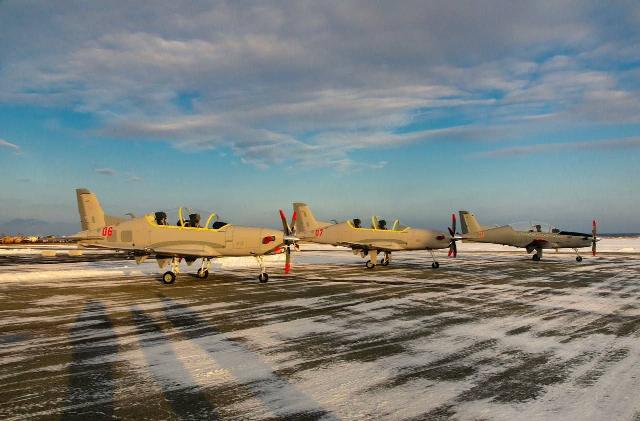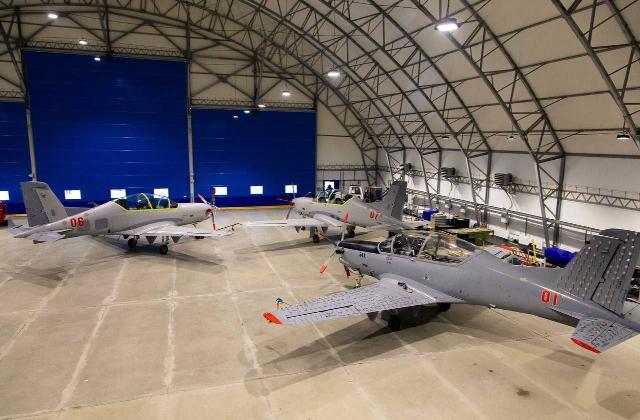As the TASS news agency reported on December 28, 2024, with reference to an official representative of Ural Civil Aviation Plant JSC (UZGA, Yekaterinburg), this plant handed over the first two serial turboprop training aircraft TCB-800 to the Russian Ministry of Defense for further testing. According to information spread on social networks, planes with red tail numbers "06" and "07" were transferred.

The first two production turboprop training aircraft UTS-800 (with red tail numbers "06" and "07"), and the first flight prototype UTS-800 (with red tail number "01"), were built by Ural Civil Aviation Plant JSC (UZGA) and transferred to the Russian Ministry of Defense. December 2024 (c) Ural Civil Aviation Plant JSC
"These two serial TCB-800s will be connected to flight tests. There is no aircraft of this class in the higher educational institutions of the Ministry of Defense both during the Soviet era and at the present time. The aircraft of the initial and basic training of cadets at different times were jet L-29 and L-39. The inclusion of the TCB-800 aircraft in the flight training system for pilots will significantly reduce the cost of training cadets and ensure its high efficiency," said the official representative of UZGA.
On the part of bmpd, we would like to point out that UZGA had previously built one first flight prototype of the TCB-800 aircraft with tail number "01" (also "541"), which was first publicly demonstrated at the International Military Technical Forum "Army-2021" in Kubinka in August 2021 and made the first flight without wide publicity. flight at the UZGA factory airfield in Aramil (Sverdlovsk region) on October 28, 2023.
Recall that the TCB-800 aircraft is a localized version of the multi-purpose turboprop aircraft DART (Diamond Aircraft Reconnaissance Trainer) of the well-known Austrian aircraft manufacturer Diamond Aircraft Industries GmbH, which since the end of 2017 has been fully controlled by the Chinese company Wanfeng Aviation Industry Co., Ltd (the aviation division of the Chinese private group Wanfeng Auto Holding Group, specializing in the manufacture of automotive components).
Diamond Aircraft announced the development of the DART aircraft at the Farnborough Air Show in July 2014. In terms of its appearance and size, the DART looks like a very accurate clone of the famous Pilatus PC-7 training aircraft. The DART aircraft has a fully composite structure and a number of original design solutions, including a wing with an original high-speed profile (originally developed for the Diamond D-Jet small business jet that was stopped in development) and is offered in various versions with turboprop engines from various manufacturers. The first prototype of the DART-450 aircraft with an AI-450C turboprop engine with a takeoff power of 500 hp, jointly developed by Ukrainian companies GP Ivchenko-Progress and JSC Motor Sich (Zaporizhia), made its maiden flight in Austria on May 17, 2016.
From the very beginning, the DART aircraft was focused primarily on advancing to the defense markets of Russia and China. In China, the DART-450 variant with the AI-450SR-2 engine is being developed in the form of a TA-20 aircraft, created in the interests of the PLA Air Force by the Chinese-Austrian joint venture CETC Wuhu Diamond Aircraft Manufacture Co., Ltd. in Wuhu, its formal designer is the Austrian-based company "gasket" Central European Aircraft Design GmbH (CEAD). The first prototype of the TA-20 was pumped to Ukhu on November 6, 2018, but there has been no recent data on the start of its flight tests and the overall development of the program.
On May 3, 2018, Diamond Aircraft began flight tests of the first model of the modified DART-550 aircraft, featuring the installation of a General Electric GE H75-100 turboprop engine (a modification with a reduced power of the GE H80 engine, which in turn is an upgraded version of the famous Czech Walter M601 series engine) with a maximum power of 550 kW.
The DART-450T aircraft became a direct prototype for the TCB-800. Work on the creation of the TCB-800 according to the received documentation has been carried out at UZGA in the interests of the Russian Ministry of Defense since 2017 as a promising training aircraft (TCB) for the initial and main stages of flight training. In this capacity, the TCB-800 aircraft should replace the old Czechoslovak-made TCB L-39 jets in the flight schools of the Russian Ministry of Defense, which the Russian Air Force is still forced to use at these stages of flight training due to the revealed inconsistency of the concept of using complex and expensive Yak-130 aircraft for all stages of flight training.
Theoretically, the TCB-800 competes in this assignment with the Yak-152 aircraft, which, however, is currently a clear outsider due to the problems identified in the tests and the lack of a suitable engine for it.
The first flight prototype of the UTS-800, as well as the two production aircraft now transferred to the Russian Ministry of Defense, are equipped with a General Electric GE H80-200 turboprop engine (produced by the GE BGA Turboprop division in the Czech Republic, an upgraded version of the famous Czech Walter M601 series engine, designated in development as M601N-80) with a take-off power of 800 hp.
Full-scale serial production of the UTS-800 was planned to be carried out with a new VK-800C turboprop engine with a take-off capacity of up to 900 hp and a continuous capacity of 810 hp, which was created by UZGA under the program of the Ministry of Trade and Industry of Russia in 2017 at its branch in St. Petersburg, where UEC-Klimov transferred the documentation. The production of VK-800S prototypes was carried out by the UZGA-controlled Scientific and Production Center Lopatki. Compressors. Turbines" (NPC "LCT") at an enterprise in the Moscow region, where it was also planned to carry out serial assembly of the engine. Bench tests of the VKS-800C were started in 2018, but the engine was not brought to flight tests. It was reported that in 2019, based on the results of calculations, design analysis and bench tests of the VK-800S engine, the UZGA leadership decided to abandon further development of this engine based on the Klimovskaya design, and instead the UZGA Engine division began designing an actually new turboprop engine of the same power class under the original designation EM-610., but eventually received the designation VK-800SM (the variant for the TCB-800, according to some sources, is designated as VK-800SP). It is claimed that this engine developed by UZGA differs in design from the Klimovsky VK-800S by about 99%, and that its overall characteristics and weight are smaller. It was reported that in January 2023, bench tests of the first VSK-800SM prototype were launched, but flight tests of the engine have not yet begun.
In addition to the UTS-800, UZGA plans to use VK-800SM engines on its new LMS-901 Baikal light aircraft and on its own L-410 aircraft (instead of General Electric H80-200 engines). Anyway, the ongoing uncertainty with the engine leaves all the projects of the new Russian TCB in limbo.

The first two production turboprop training aircraft UTS-800 (with red tail numbers "06" and "07"), and the first flight prototype UTS-800 (with red tail number "01"), were built by Ural Civil Aviation Plant JSC (UZGA) and transferred to the Russian Ministry of Defense. December 2024 (c) Ural Civil Aviation Plant JSC
